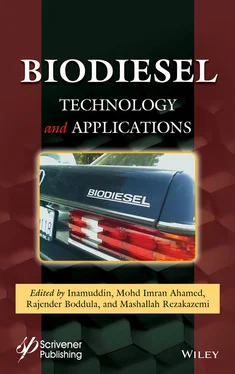In order to produce economically feasible and cost-effective enzymatic biodiesel production, various methods have been used. For example, improvement in purification procedures, use of better bioreactors, various immobilization techniques, use of easy to handle solvents and solution, finding novel organisms that can produce more stable and effective lipases. These genetic manipulations enable recombinant organism to overexpress active lipases. A lot of work has been done to produce recombinant lipases from recombinant organisms by deriving desired gene from another specie or organism to meet our demands. According to Huang et al . [173], a good conversion of microalgal oil into FAME and FAEE was obtained (<90%) when recombinant lipase from Rhizomucor miehei was expressed in Pichia pastoris , in the presence of methanol and ethanol as acyl acceptor, respectively. That recombinant lipase enzyme was called Lipase GH2 and it was used as free enzyme for catalysis. Aspergillus oryzea has been used majorly for lipase expression as manipulating organism. Adachi et al . [174] created thermostable and solvent tolerant whole-cell biocatalysts that worked as robust biocatalyst for bio-diesel production. Geobacilus thermocatenulatus was used as a source organism from which thermostable lipase (BTL2) gene was obtained and then introduced into Aspergillus oryzea (r-BTL). Immobilized whole-cell r-BTL was then used to convert palm oil into FAME production and the resultant yield obtained was 100%. Whole-cell biocatalyst tolerated 40-50°C temperature and 30% (v/v) solvents such as methanol, DMC, and acetone. These results proved the thermostability and solvent tolerance of Aspergillus oryzea (r-BTL). Lipase from B68 strain of Pseudomonas fluorescence (lipB68) was transformed into E. coli BL21 which resulted in 92% yield upon transesterification. The amazing thing about this experiment was use of that novel psychrophilic lipase (lipB68) that catalyzed reaction at 20°C and energy consumption became reduced in the reaction system [175]. So, use of psychrophilic lipase for biodiesel production can become more useful in the future. In many research experiments, recombinant lipases have performed better than commercially used lipases. For example, according to Yan et al . [176], recombinant Pichia pastoris strain was developed that used to overexpress Thermomyces anuginosus lipase. When this strain was used as a whole-cell biocatalyst, it efficiently converted waste cooking oil into FAME with 82% yield within 84 h. After comparing this recombinant strain performance with commercial lipase Lipozyme TLIM, it was found that the earlier one outperformed the later one. In another research, lipase LIP2 coding gene was cloned from Candida rugosa and expressed in Pichia pestoris after changing some codons of that gene by side directed mutagenesis to make it more useful and active. So, then that recombinant Candida rugose gave better results when results of commercial C.rugosa lipase and recombinant LIP4 were compared because recombinant LIP2 lipase was tolerating temperature 30°C–50°C and work even at 70°C [177]. A lot of research has been done in utilizing recombinant lipases and found better results. Tables 1.5and 1.6showed some examples of recombinant whole-cell lipases with and without immobilization.
Table 1.5 Some research investigations using recombinant whole-cell biocatalyst after immobilization.
| Expressing lipase source |
Immobilized on |
Substrate |
Acyl acceptor |
Yield |
Reference |
| Fusarium heterosporum |
Biomass support particles |
Aqueous plant oil emulsion |
Methanol |
96.1% |
[178] |
| Soybean oil |
Methanol |
98% |
[179] |
| Thermomyces lanuginosus |
Protein-coated microcrystals |
Palm olein |
Ethanol |
89.9% |
[180] |
| Crude palm oil |
82.1% |
| Palm fatty acid distillate |
75.5% |
| Geobacillus thermocatenulatus (BTL2) |
Reticulated polyurethane foam BSPs |
Palm oil |
Methanol |
~100% |
[174] |
| Proteus mirabilis |
hydrophobic Immobead 350 oxirane functionalized beads |
Canola oil |
Methanol |
76% |
[181] |
| Staphylococcus haemolyticus L62 |
poly (methacrylate-co-divinyl benzene) resin |
Olive oil |
Methanol |
90% |
[182] |
1.10 Immobilization of Lipases for Better Biodiesel Production
Immobilization is the physical binding of enzymes to a solid support in such a way that when the substrate passes over the enzyme support it converted into their product [189]. The vast use of Enzyme immobilization technique at industrial scale is because it results in enzyme stabilization and prolonged enzyme–substrate contact which results in reduction of purification steps. Further, it lowers the reaction cost by making the reaction contamination free and enabling recycling of the enzyme [190]. As the cost of industrial production of lipase enzyme is one of the main obstacle in its industrial application, so it can be eliminated through lipase immobilization [191]. Industrial processes/reactions can be made continuous with little protein using immobilized lipases because of their easy separation from reaction system containing products, by-products, residual substrates, and medium [192]. In transesterifications is the main process involves in biodiesel production using lipase enzyme, the use of immobilized enzyme (extracellular) and immobilized whole-cell (intracellular enzyme) both reported highly efficient as compared to the use of free enzymes. Bayramoglu et al . [59] set two reaction setups, one with free enzyme and other using immobilized enzyme, and then reaction comparison was measured using gas chromatography-mass spectrophotometry (GC-MS) by noticing FAME components. They Candida rugosa lipase was immobilized on microporous bio-silica polymer. Both enzymes then further used for transesterification of Scenedesmus quadricauda microalgal oil using methanol in the presence of n-hexane solvent. Reaction setup having immobilized lipase produced 96.4% yield as compared to free lipase that produced 85.7% yield. Moreover, immobilized lipase was very much stable as it just lost 17% of its activity after six cycles. Kalantari et al . [193] used Pseudomonas cepacia lipase, immobilized on mixture of mesoporous and nanoporous silica coated composite particles, for transesterification of soybean oil into FAME using methanol. Immobilization effect retains 55% enzymatic stability after five consecutive cycles compared to free lipase reaction. Shah et al . [194] showed that three enzymes were selected initially and then Chromobacterium viscosum was further chosen because of its better results. Celite 545 was used as immobilization material applied to enzyme. Transesterification of Jatropha oil using ethanol was conducted with and without immobilized lipase. After immobilization, reaction yield increased from 62% to 71% and then after further addition of water and immobilization, it reached to 92%. Moreover, in another study [85], triolein transesterification was conducted using methanol, ethanol, and immobilized Pseudomonas fluorescens in the presence of 1,4-dioxane solvent. Reaction yield for both free and immobilized lipase reaction setups was same, i.e., 90%. But the stability provided by immobilization, loss of lipase activity was minimal in immobilized reaction setup than other. Reaction time was 10h for immobilized as compared to 25h reaction time in free lipase system. Further, when we use water free media, free enzyme molecules tend to clump together and decreasing the surface area. Enzyme immobilization inhibit clump formation and increase the surface area of the biocatalyst [195]. Kumari et al . [97] carried out transesterification of jatropha oil with Enterobacter aerogenes lipase immobilized on surface and reported high yield (94%) of biodiesel production and noticed that lipase activity reduced in little extent even after repeated use. Enzyme properties like resistance to proteolytic digestion and denaturants, temperature profile, pH-dependence, thermostability, and kinetics are mainly affected by enzyme immobilization. The chief issues for enzyme immobilization are preference for the selection of immobilization techniques and support matrices that permit both rapid enzyme activity and enzyme stability under the constraints imposed by the substrate medium [89, 196]. Some examples of different investigations regarding biodiesel production methods using whole-cell immobilized biocatalysts are given in Table 1.7.
Читать дальше












